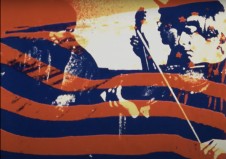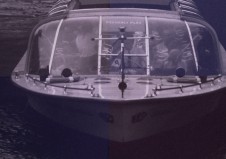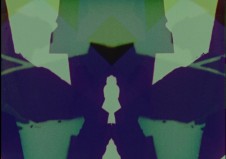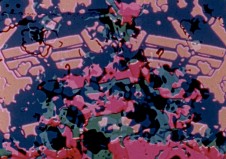Muscle Beach to Berlin: Classic and New Films by Pat O'Neill with Golia/ Feeney/King/ LeVeque

Easyout, by Pat O'Neill
Sunday, April 28, 2024, 7:30 pm
At 2220 Arts + Archives, 2220 W. Beverly Blvd., Los Angeles CA
Classic films by Pat O’Neill with live music by Vinny Golia, Holden King, Tim Feeney, and Matt LeVeque!
Tickets: $25 general, $15 for Filmforum members
At https://link.dice.fm/W264e3d185f9
Masks are highly recommended at Filmforum shows - N95 or KN95.
Pat O’Neill first had a solo screening at Filmforum in 1979, and Vinny Golia played a concert at Filmforum in 1980! And they are back and raring to go! We look forward to sharing this special collaboration with the public for the first time. We’ll be showing three short films of Pat’s with their original sound, then four films with live music played by the bank, all from 16mm. A one-of-a-kind experience!
Special Thanks to Martha Colburn for putting it together.
The band:
Known As Holden King
Vinny Golia- Clarinet/Woodwinds
Tim Feeney- Percussion
Matt LeVeque- Vibraphone/Percussion
Holden King- Bass
Bios:
Pat O’Neill has been deeply involved in Los Angeles culture since the late 1960’s. A founding father of the city’s avant-garde film scene, an influential professor at Cal Arts and an optical effects pioneer, he is best known for his short works from the early 1960’s onwards which are highly graphic, layered and reflexive assemblages based on a mastery of optical printing techniques. In O’Neill’s films boundaries fade, narrative collapses and layers of imagery draw the viewer simultaneously towards and away from linear meaning. O’Neill has combined found footage with experimental montage and compositing techniques to create a graphic language that deals with how different, often disparate elements assembled together in the frame relate to one another. His innovative optical techniques anticipated our digital landscape well before its time.
The Band- Known as Holden King is a lot of things. A comedic interaction. An interplay between friends and intellectuals. The likely result of all that’s great about improvised and emotional music wrapped into one avant grade package. An opportunity brimming with potential for expansion on thematic material and esoteric communication. A lovely storytelling experience and a meeting of the minds.
Holden King is a Multi Instrumentalist improviser, and filmmaker poet based in Los Angeles California. His work both musical and otherwise focuses heavily on themes of humanity and subconscious communication through improvisation and automatic storytelling. He has worked with the likes of the greats like Ulrich Kreiger, Vinny Golia, Tim Feeney, Chris Speed, and Ghanaian legend Sulley Imorro.
Matt LeVeque (b.1996) is a percussionist, composer, and improviser based in Los Angeles. His work centers around questions of intimacy, relationality, nostalgia, and absence, in pursuit of an aesthetic of queer futurity. In addition to instrumental concert music, his work expands to include electronic music, sound and video installations, films, intermedia performance, and written text. Matt is currently pursuing a Performer- Composer DMA at the California Institute of the Arts.
Tim Feeney performs, composes, improvises, and builds environments in and for forests and grain silos, specifically concerned with unstable sound and duration. He appears in bookstores and basements with Sarah Hennies and Greg Stuart as the trio Meridian; in galleries and libraries with Vic Rawlings, Cassia Streb, and Annie Lewandowski; in colleges and museums with Andrew Raffo Dewar, Holland Hopson, and Jane Cassidy; on recordings for Full Spectrum, Sedimental, and Marginal Frequency; and in the occasional festival or concert hall with Anthony Braxton, Ingrid Laubrock, and the Partch Ensemble. He is a faculty member in percussion, improvisation, and composition at the California Institute of the Arts.
Vinny Golia is a composer, instrumentalist, monster movie aficionado, and educator who is among the most respected musicians in Los Angeles/NYC. He owns the most complete and eclectic collection of woodwind instruments this side of the Mississippi and is an innovator on all of them. Throughout his career he has worked with Anthony Braxton, Bobby Bradford, Wadada Leo Smith, Ken Filliano and countless other massively influential composers and improvisers. He is the founder of the prolific label Nine Winds and a Faculty member in the Performer Composer program at California Institute of the Arts.
Berlin 1990 (excerpt)
2016, digital video, color, sound, Approx ten minutes from 28 min. total

Coming Down
Coming Down
1968, 16mm, solor, sound, 3 min.
Sound: The United States of America
A psychedelic promo film made by Pat O'Neill for Joseph Byrd's band The United States of America. According to O'Neill, the band broke up before the film could be used. Heavily manipulated imagery of the group performing their song 'Coming Down' is intercut with cascading, colorized found footage.

Preen Scene
Preen Scene
2024, digital video, color, sound, 5 min.
World Premiere!
Sound: Organza Ray (Berlin) - as heard on the new album 'The Future Sounds of Kraut
By the Sea
Sound by the band
1963, 16mm, b&w, 10 min.
Pat O'Neill began filmmaking as an extension of photography with a "documentary" BY THE SEA (1962), co-produced with Bob Abel (who later became famous for his advertising films), for the finale of which O'Neill printed images of beach activities on high-contrast film for a dazzling sun effect, and edited them in crisp dynamic rhythms.
In retrospect, the erotic biomorphism that recurs throughout O'Neill's sculptures, collage-drawings, and (especially, early) films seems to have emerged from his 1961 Atlantic Auto Wrecking Series photographs: A pair of mismatched oblong fenders with almond-shaped headlights, for example, reappears as dark ovals in the high-contrast ending of his first film, BY THE SEA (made with Robert Abel, 1963), in the twin orbs that open 7362, and in the oscillating circles of TWO SWEEPS (1979).
[Source: Moritz, William. "Pat O'Neill." L'art du Mouvement 1919-1996. Ed. Jean-Michel Bouhours, Cinéma du Musée National d'Art Moderne, Paris: Centre Pompidou, 1996, 347-348.]

7362
7362
Sound by the band
1967, 16mm, color, 10 min.
The most highly acclaimed psychedelic abstract film since LAPIS. A combination of innumerable optical techniques, this film hints at the schizophrenic conditions of our 20th Century mechanical-conformist society, using, in part, Rorschach tests in motion and schizoid distortions of the nude female form. 'Named after the high speed emulsion on which it was made, 7362 is a brilliant, visceral barrage of high contrast positive-negative images; a stream Rorschach-like silhouettes, suggesting the movements of both body and machine.' - MEDIA & METHODS. 'This is film as art in pure presentational form. Patrick O'Neill has utilized color, sound, and images in a symphonic mode, attacking the consciousness with unusual power. 7362 does not say anything, but simply is, in the way that a kaleidoscope IS the shapes, images and colors presented to the eye. Groups who want to break away from seeing cinema as stories with morals will find this a stirring introduction to the real possibilities of the form.' - CHRISTIAN ADVOCATE. [Source: Creative Film Society Catalog, 1975]

Easyout
Easyout
Sound by the band
1971, 16mm, color, 9 min.
Has to do with a consideration of one possible conceptual model for human existence: that of a primitive form of yardchair, upon which sits The Creator, impassively observing the inexorable flow of His mountains. The name EASYOUT is derived from a commercially available bolt and stud-extracting tool, whose function seemed strangely parallel to that of the film.
Awards: First Prize, Kurzfilmtage Oberhausen Film Festival, 1972; First Prize, Yale Film Festival, 1972. - [Source: Canyon Cinema Catalog]

Saugus Series
Saugus Series
1974, 16mm, color, 18 min.
Actually, seven short films, one-and-a-half to six minutes long, united by a common soundtrack. Each is an evolving "still life," made up of meticulously assembled but spatially contradictory elements. For example, in one part the sun can be seen, by its shadows, to be traveling in one direction in the upper half of the screen, and in the opposite in the lower half. Commentary on Part 5: P: Now you might say this is an interesting sort of design .... B: But after a while you'd grow tired of looking at it. It would lack interest. P: And so the artist must always temper his repetition of movements of forms with what might be called a certain amount of variety. B: Suppose I enlarged some of them, changed their direction, make some smaller, add dark values and lighter values .... P: Or perhaps a tree, sharply contrasting in value from the surrounding shapes. B: There is sharp contrast, at this point, between the fan and the surrounding objects in a Great Triangle someplace perhaps a mile or a mile and a half above the surface of the Earth. P: And here we see order; order which includes omission and alternation from nature. Award: Tom Berman Award, Ann Arbor Film Festival, 1975 [Source: Filmmaker's Cooperative Online Catalogue]
